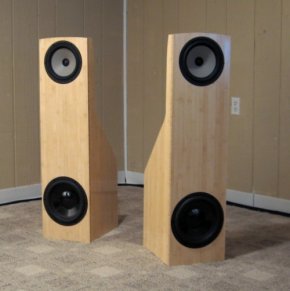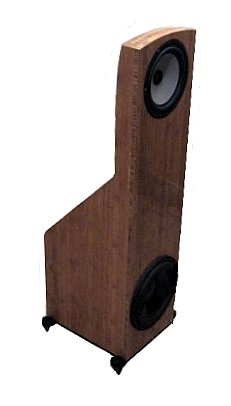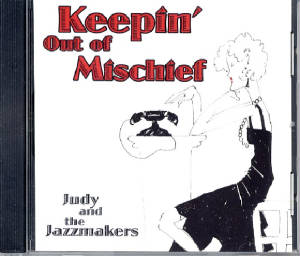Nomad Audio Ronin 1.0c
| Nomad Audio Ronin 1.0c |
| A new contender emerges |
|
|
|
February 2007 |

A new contender emerges
Nomad Audio is a new company located in Arlington Heights, Illinois, and is the brainchild of owner and chief designer, Paul Hilgeman. I met Paul through a mutual friend, who, like Paul, is a speaker builder. My friend told me that Paul did not live too far away from me and that he makes a very nice speaker that he had heard himself and felt I might enjoy listening to. So I contacted Paul and he was kind enough to invite me over for a listening session.
Paul is a very bright and articulate man who is very thorough and very meticulous in the things his does, but most of all, is a music lover. Paul is one of those persons who (when he gets together with another techno-geek like me) speaks a totally different version of English, loaded with obscure references to the names and brands of all sorts of speaker drivers and crossover parts. Eventually, we got around to talking about me doing a review of one of his speakers and soon after, Paul had a pair of his Ronin 1.0c delivered to my house.
Listening to the customer

Any discussion pertaining to the design concepts of the Ronins has to start with how their drivers are configured. The Ronins are a di-polar design, meaning that sound radiates from the front and rear of the tweeter/midrange drivers. Speaking of the tweeter and midrange, both are made by SEAS of Norway. The 1” silk dome tweeter actually resides in the middle of an 8.5” magnesium midrange driver, giving you a true point source radiator. When this is done properly, you get what sounds like a seamless and smooth integration between the two. If this type of configuration is not done properly you can get problems with beaming and sonic diffraction, neither of which were an issue for the Ronins.
For bass performance, the Ronins utilize a Dayton 10.5” aluminum woofer in a sealed box enclosure. I asked Paul what thinking went into his selection of drivers for this speaker. “The selection of Aluminum and Magnesium for the woofer and midrange was due to low distortion and increased clarity when they are used properly,” said Paul. “Unlike paper, polypropylene, Kevlar, or other softer materials, they do not start flexing, until higher frequencies. Many speakers that use drivers made of softer materials are forced to use the driver while it is flexing, i.e. it is in the ‘pass band’. With magnesium and aluminum, the frequencies at which it starts flexing are pushed well above the crossover point, and are not in the pass band, therefore you don’t hear this coloration,” Paul said.
Paul designed the Ronins to use a 3rd order crossover between the woofer and midrange at 250Hz and a 4th order crossover between the midrange and tweeter at 1350Hz. He has some definite ideas about the way things should be built and the way he carries out his design, but it wouldn’t mean much if those ideas did not translate into a musically satisfying speaker.
So what did they sound like?
 In my opinion, any discussion of the Nomad Audio Ronins should begin with their midrange. That magnesium midrange driver provides the listener with a wonderfully musical midrange performance that is also very involving. I don’t know if it’s due to listening to midrange drivers on a multitude of speakers that were only 3” – 6” or if it’s the excellence of execution on Paul Hilgeman’s part, but the Ronin’s 8.5” magnesium midrange driver simply allows more of what’s going on in the music to be heard and enjoyed. Instruments have a naturalness to them that adds to the sense of sounding “real”. The high frequency performance of these speakers is also good. Highs are airy and extended, triangles, cymbals and xylophones are vibrant and sweet with a lingering decay and hall sounds, from live concerts, provide subtle clues about the venue where the recording was made. Image placement is also a strength of these speakers and one of the best that I have had in my listening room. The stage width is wall to wall and the depth seemed to extend back past the boundaries of my rear wall. The low frequency performance with these speakers in my room was excellent. The bass was never bloated, loose or boomy, but always tight, extended and had good impact. Tonally, the Ronins are what could be described as neutral, possessing neither a tubey sound nor one that’s overly detailed. If the music calls for it, the speakers can sound tonally rich or, if the music comes across as being lean and detailed, like on some of the Deutsche Grammophone recordings I have, that’s exactly what you’ll get from the Ronins.
In my opinion, any discussion of the Nomad Audio Ronins should begin with their midrange. That magnesium midrange driver provides the listener with a wonderfully musical midrange performance that is also very involving. I don’t know if it’s due to listening to midrange drivers on a multitude of speakers that were only 3” – 6” or if it’s the excellence of execution on Paul Hilgeman’s part, but the Ronin’s 8.5” magnesium midrange driver simply allows more of what’s going on in the music to be heard and enjoyed. Instruments have a naturalness to them that adds to the sense of sounding “real”. The high frequency performance of these speakers is also good. Highs are airy and extended, triangles, cymbals and xylophones are vibrant and sweet with a lingering decay and hall sounds, from live concerts, provide subtle clues about the venue where the recording was made. Image placement is also a strength of these speakers and one of the best that I have had in my listening room. The stage width is wall to wall and the depth seemed to extend back past the boundaries of my rear wall. The low frequency performance with these speakers in my room was excellent. The bass was never bloated, loose or boomy, but always tight, extended and had good impact. Tonally, the Ronins are what could be described as neutral, possessing neither a tubey sound nor one that’s overly detailed. If the music calls for it, the speakers can sound tonally rich or, if the music comes across as being lean and detailed, like on some of the Deutsche Grammophone recordings I have, that’s exactly what you’ll get from the Ronins.
 On the Judy and the Jazzmakers disc, Keepin’ Out of Mischief [Coherent Recordings 501] the Ronins provide a glimpse to their imaging qualities with all of the performers occupying their own space. The Ronins provide you with believably life like, tangible images with a large sound stage. There is also a stunning sense of depth as the musicians definitely performing in back of lead vocalist Judy Marshak. Another wonderfully recorded work is the Tin Hat Trio’s CD, The Rodeo Eroded [Ropeadope Records] produces some of the most palpable, real sounding macro and micro dynamics that I have heard on a disc. The Ronins drivers are fast and had no problem allowing you to follow all of the percussive sounds and various stringed instruments on display on this album. Transients had the requisite snap and impact without sounding dull or rounded off. On Mark O’Connor Hot Swing Trio CD, In Full Swing [Odyssey SK 87880], Jane Monheits vocals, reproduced on the Ronins is a treat. On the tracks, “Honeysuckle Rose”, “Misty” and “Fascinating Rhythm”, we can hear the vocals with proper height, life-like dynamics and images, without any exaggerated sibilance.
On the Judy and the Jazzmakers disc, Keepin’ Out of Mischief [Coherent Recordings 501] the Ronins provide a glimpse to their imaging qualities with all of the performers occupying their own space. The Ronins provide you with believably life like, tangible images with a large sound stage. There is also a stunning sense of depth as the musicians definitely performing in back of lead vocalist Judy Marshak. Another wonderfully recorded work is the Tin Hat Trio’s CD, The Rodeo Eroded [Ropeadope Records] produces some of the most palpable, real sounding macro and micro dynamics that I have heard on a disc. The Ronins drivers are fast and had no problem allowing you to follow all of the percussive sounds and various stringed instruments on display on this album. Transients had the requisite snap and impact without sounding dull or rounded off. On Mark O’Connor Hot Swing Trio CD, In Full Swing [Odyssey SK 87880], Jane Monheits vocals, reproduced on the Ronins is a treat. On the tracks, “Honeysuckle Rose”, “Misty” and “Fascinating Rhythm”, we can hear the vocals with proper height, life-like dynamics and images, without any exaggerated sibilance.

Winding things up
I have been somewhat in speaker review mode recently, what with doing reviews on Almarro Audio’s M3A, the LSA Group’s LSA2 and the Nomad Ronins. At more than twice the price of those other speakers, the $4,500 Ronins have more to offer you in terms of the music and performance. In this instance, the extra price is justified in the return you get for your money. While those other speakers are good performers and bargains at their price points, the Ronins are a step up in musicality, detail, bass and upper frequency extension, and the ability to draw you in to the music and communicate with the artists. The Ronin’s palette has a large supply of tonal colors and subtle shadings that lends it self to the feeling that you’re experiencing the performance being reproduced live in your room. They never had any trouble filling my room with sound and never sounded stressed or strained but were always under control.
The Ronins throw an easy load for amplifiers to drive. For those of you who like to play their music into the wee hours of the morning, I was able to get enough output at low levels that allowed me to enjoy the music without disturbing my wife. The Ronins don’t have quite the level of detail of electrostatic speakers, however, electrostatics can’t throw a stage nowhere near as large and lifelike or with the level of power and realism of the live music that the Ronins possess. The Ronins’ presentation with the Esoteric DV50S in the system was very good and outstanding with the Accuphase DP-67 used as the primary source. The best sound I felt I had during the review period, as noted above, was the Ronin’s performance when using my Merrill Heirloom vinyl rig. Anyone who still listens to vinyl would be very impressed with how their albums sound being played on an analogue front end coming through these speakers. Another attribute I liked about the Ronins was how well they performed with the various cables I played through them. The excellent sounding, and very affordable, Mood Acoustics did a good job, as did the Sunny Cable Technology cables and the DCCA Audio Eminence. The best sounding cables I had on hand were those from Dynamic Design.
One of the more telling performance indicators that I always take note of, when reviewing speakers, is how guests react to them whenever I’m hosting a listening session. On one occasion in particular, I had two of my oldest friends over who are die hard, card-carrying planar speaker fanatics. When they first arrived and asked what we were going to be listening to, they told me, “you got to get out the box, Mike.” By the time we were done listening, they conceded that this was one of those rare times where they hear dynamic speakers that they would consider buying even over planar speakers. For them to say that, that was saying a lot. Pretty much everyone that came over to do some listening during the review period was impressed by what they heard. With their build quality and excellent performance, I heartily give the Nomad Ronins a “very enthusiastic” recommendation and would urge anyone looking for speakers in the $5,000 – $7,000 range to give these a listen.
Michael Wright
_____________________
Specifications
Dimensions: 42” Tall, 11.25” Wide, 14” Deep
Weight: 75lbs each
Construction: Biscuit Jointed Cross-Ply Bamboo Panels
Woofer Loading: Sealed Box, Q=.65
Woofer: 27cm Long Throw Aluminum Cone 0-250Hz, Copper Shorting Rings.
Midrange: 22cm magnesium cone 250-1350Hz, Copper Shorting Rings.
Tweeter: 28mm Silk Dome, Light Weight Fero-fluid, Neodymium Ring Motor.
Impedance: 3.5-12 Ohms across entire audio band
Electrical Phase: -30 to +35 degrees across entire audio band
Frequency Response: +/- 1.25dB from 40 to 6.5Khz and +1.25 or +1.25, -3dB from 36 to 24Khz. Real bass response will reach into low 20’s in typical listening rooms.
Price:$4,500.00
Manufacturer
Nomad Audio
626 S. Dunton
Arlington Heights, IL. 60005
Phone: 847-847-8525
E-Mail: info@nomad-audio.com
Website: http://www.nomad-audio.com
![]()
Don’t forget to bookmark us! (CTRL-SHFT-D)
Stereo Times Masthead
Publisher/Founder
Clement Perry
Editor
Dave Thomas
Senior Editors
Frank Alles, Mike Girardi, Key Kim, Russell Lichter, Terry London, Moreno Mitchell, Paul Szabady, Bill Wells, Mike Wright, Stephen Yan, and Rob Dockery
Current Contributors
David Abramson, Tim Barrall, Dave Allison, Ron Cook, Lewis Dardick, Dan Secula, Don Shaulis, Greg Simmons, Eric Teh, Greg Voth, Richard Willie, Ed Van Winkle, and Rob Dockery
Music Reviewers:
Carlos Sanchez, John Jonczyk, John Sprung and Russell Lichter
Site Management Clement Perry
Ad Designer: Martin Perry





Be the first to comment on: Nomad Audio Ronin 1.0c